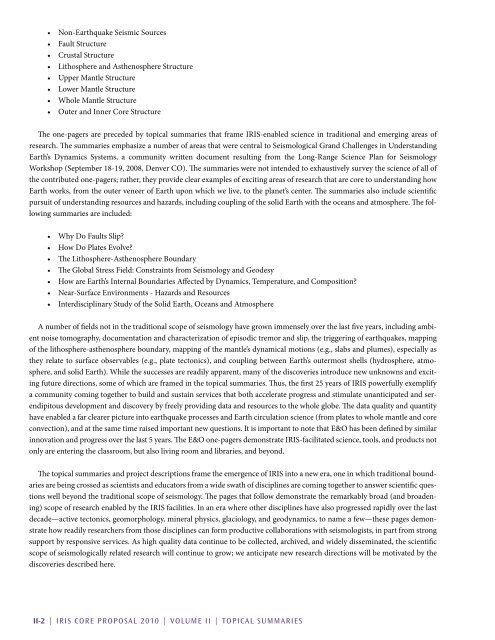Accomplishments - IRIS
Accomplishments - IRIS
Accomplishments - IRIS
You also want an ePaper? Increase the reach of your titles
YUMPU automatically turns print PDFs into web optimized ePapers that Google loves.
• Non-Earthquake Seismic Sources<br />
• Fault Structure<br />
• Crustal Structure<br />
• Lithosphere and Asthenosphere Structure<br />
• Upper Mantle Structure<br />
• Lower Mantle Structure<br />
• Whole Mantle Structure<br />
• Outer and Inner Core Structure<br />
The one-pagers are preceded by topical summaries that frame <strong>IRIS</strong>-enabled science in traditional and emerging areas of<br />
research. The summaries emphasize a number of areas that were central to Seismological Grand Challenges in Understanding<br />
Earth’s Dynamics Systems, a community written document resulting from the Long-Range Science Plan for Seismology<br />
Workshop (September 18-19, 2008, Denver CO). The summaries were not intended to exhaustively survey the science of all of<br />
the contributed one-pagers; rather, they provide clear examples of exciting areas of research that are core to understanding how<br />
Earth works, from the outer veneer of Earth upon which we live, to the planet’s center. The summaries also include scientific<br />
pursuit of understanding resources and hazards, including coupling of the solid Earth with the oceans and atmosphere. The following<br />
summaries are included:<br />
• Why Do Faults Slip?<br />
• How Do Plates Evolve?<br />
• The Lithosphere-Asthenosphere Boundary<br />
• The Global Stress Field: Constraints from Seismology and Geodesy<br />
• How are Earth’s Internal Boundaries Affected by Dynamics, Temperature, and Composition?<br />
• Near-Surface Environments - Hazards and Resources<br />
• Interdisciplinary Study of the Solid Earth, Oceans and Atmosphere<br />
A number of fields not in the traditional scope of seismology have grown immensely over the last five years, including ambient<br />
noise tomography, documentation and characterization of episodic tremor and slip, the triggering of earthquakes, mapping<br />
of the lithosphere-asthenosphere boundary, mapping of the mantle’s dynamical motions (e.g., slabs and plumes), especially as<br />
they relate to surface observables (e.g., plate tectonics), and coupling between Earth’s outermost shells (hydrosphere, atmosphere,<br />
and solid Earth). While the successes are readily apparent, many of the discoveries introduce new unknowns and exciting<br />
future directions, some of which are framed in the topical summaries. Thus, the first 25 years of <strong>IRIS</strong> powerfully exemplify<br />
a community coming together to build and sustain services that both accelerate progress and stimulate unanticipated and serendipitous<br />
development and discovery by freely providing data and resources to the whole globe. The data quality and quantity<br />
have enabled a far clearer picture into earthquake processes and Earth circulation science (from plates to whole mantle and core<br />
convection), and at the same time raised important new questions. It is important to note that E&O has been defined by similar<br />
innovation and progress over the last 5 years. The E&O one-pagers demonstrate <strong>IRIS</strong>-facilitated science, tools, and products not<br />
only are entering the classroom, but also living room and libraries, and beyond.<br />
The topical summaries and project descriptions frame the emergence of <strong>IRIS</strong> into a new era, one in which traditional boundaries<br />
are being crossed as scientists and educators from a wide swath of disciplines are coming together to answer scientific questions<br />
well beyond the traditional scope of seismology. The pages that follow demonstrate the remarkably broad (and broadening)<br />
scope of research enabled by the <strong>IRIS</strong> facilities. In an era where other disciplines have also progressed rapidly over the last<br />
decade—active tectonics, geomorphology, mineral physics, glaciology, and geodynamics, to name a few—these pages demonstrate<br />
how readily researchers from those disciplines can form productive collaborations with seismologists, in part from strong<br />
support by responsive services. As high quality data continue to be collected, archived, and widely disseminated, the scientific<br />
scope of seismologically related research will continue to grow; we anticipate new research directions will be motivated by the<br />
discoveries described here.<br />
II-2 | <strong>IRIS</strong> Core Proposal 2010 | Volume II | Topical Summaries

















